Files in this item
Managing the effects of multiple stressors on wildlife populations in their ecosystems : developing a cumulative risk approach
Item metadata
| dc.contributor.author | Tyack, Peter Lloyd | |
| dc.contributor.author | Thomas, Len | |
| dc.contributor.author | Costa, Daniel | |
| dc.contributor.author | Hall, Ailsa Jane | |
| dc.contributor.author | Harris, Catriona M | |
| dc.contributor.author | Harwood, John | |
| dc.contributor.author | Krauss, Scott | |
| dc.contributor.author | Miller, Patrick James | |
| dc.contributor.author | Moore, Michael | |
| dc.contributor.author | Photopoulou, Theoni | |
| dc.contributor.author | Pirotta, Enrico | |
| dc.contributor.author | Rolland, Rosalind | |
| dc.contributor.author | Schwacke, Lori | |
| dc.contributor.author | Simmons, Samantha | |
| dc.contributor.author | Southall, Brandon | |
| dc.date.accessioned | 2022-12-06T17:30:07Z | |
| dc.date.available | 2022-12-06T17:30:07Z | |
| dc.date.issued | 2022-11-30 | |
| dc.identifier | 281943661 | |
| dc.identifier | 6a889707-674c-4bad-84bb-2720e1455003 | |
| dc.identifier | 85143054585 | |
| dc.identifier | 000892414000002 | |
| dc.identifier.citation | Tyack , P L , Thomas , L , Costa , D , Hall , A J , Harris , C M , Harwood , J , Krauss , S , Miller , P J , Moore , M , Photopoulou , T , Pirotta , E , Rolland , R , Schwacke , L , Simmons , S & Southall , B 2022 , ' Managing the effects of multiple stressors on wildlife populations in their ecosystems : developing a cumulative risk approach ' , Proceedings of the Royal Society of London Series B: Biological Sciences , vol. 289 , no. 1987 , 20222058 . https://doi.org/10.1098/rspb.2022.2058 | en |
| dc.identifier.issn | 0962-8452 | |
| dc.identifier.other | ORCID: /0000-0002-7562-1771/work/124078471 | |
| dc.identifier.other | ORCID: /0000-0002-8409-4790/work/124078594 | |
| dc.identifier.other | ORCID: /0000-0003-3541-3676/work/124078604 | |
| dc.identifier.other | ORCID: /0000-0001-9616-9940/work/124078661 | |
| dc.identifier.other | ORCID: /0000-0002-7436-067X/work/124078716 | |
| dc.identifier.other | ORCID: /0000-0001-9198-2414/work/124079127 | |
| dc.identifier.uri | https://hdl.handle.net/10023/26549 | |
| dc.description | Funding: Office of Naval Research - N000142012697, N000142112096; Strategic Environmental Research and Development Program - RC20-1097, RC20-7188, RC21-3091. | en |
| dc.description.abstract | Assessing cumulative effects of human activities on ecosystems is required by many jurisdictions, but current science cannot meet regulatory demands. Regulations define them as effect(s) of one human action combined with other actions. Here we argue for an approach that evaluates the cumulative risk of multiple stressors for protected wildlife populations within their ecosystems. Monitoring effects of each stressor is necessary but not sufficient to estimate how multiple stressors interact to affect wildlife populations. Examining the mechanistic pathways, from cellular to ecological, by which stressors affect individuals can help prioritize stressors and interpret how they interact. Our approach uses health indicators to accumulate the effects of stressors on individuals and to estimate changes in vital rates, driving population status. We advocate using methods well-established in human health and integrating them into ecosystem-based management to protect the health of commercially and culturally important wildlife populations and to protect against risk of extinction for threatened species. Our approach will improve abilities to conserve and manage ecosystems but will also demand significant increases in research and monitoring effort. We advocate for increased investment proportional to the economic scale of human activities in the Anthropocene and their pervasive effects on ecology and biodiversity. | |
| dc.format.extent | 15 | |
| dc.format.extent | 1554984 | |
| dc.language.iso | eng | |
| dc.relation.ispartof | Proceedings of the Royal Society of London Series B: Biological Sciences | en |
| dc.subject | Ecosystem | en |
| dc.subject | Cumulative risk | en |
| dc.subject | Endangered species | en |
| dc.subject | Stressors | en |
| dc.subject | Cumulative effects | en |
| dc.subject | Population | en |
| dc.subject | GF Human ecology. Anthropogeography | en |
| dc.subject | QH301 Biology | en |
| dc.subject | NDAS | en |
| dc.subject | SDG 3 - Good Health and Well-being | en |
| dc.subject | MCC | en |
| dc.subject.lcc | GF | en |
| dc.subject.lcc | QH301 | en |
| dc.title | Managing the effects of multiple stressors on wildlife populations in their ecosystems : developing a cumulative risk approach | en |
| dc.type | Journal article | en |
| dc.contributor.institution | University of St Andrews. Statistics | en |
| dc.contributor.institution | University of St Andrews. Marine Alliance for Science & Technology Scotland | en |
| dc.contributor.institution | University of St Andrews. Centre for Research into Ecological & Environmental Modelling | en |
| dc.contributor.institution | University of St Andrews. Sea Mammal Research Unit | en |
| dc.contributor.institution | University of St Andrews. Scottish Oceans Institute | en |
| dc.contributor.institution | University of St Andrews. School of Biology | en |
| dc.contributor.institution | University of St Andrews. Centre for Energy Ethics | en |
| dc.contributor.institution | University of St Andrews. Office of the Principal | en |
| dc.contributor.institution | University of St Andrews. Institute of Behavioural and Neural Sciences | en |
| dc.contributor.institution | University of St Andrews. Centre for Social Learning & Cognitive Evolution | en |
| dc.contributor.institution | University of St Andrews. Bioacoustics group | en |
| dc.contributor.institution | University of St Andrews. School of Mathematics and Statistics | en |
| dc.identifier.doi | 10.1098/rspb.2022.2058 | |
| dc.description.status | Peer reviewed | en |
This item appears in the following Collection(s)
Items in the St Andrews Research Repository are protected by copyright, with all rights reserved, unless otherwise indicated.

